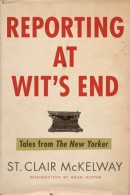 St. Clair McKelway, a reporter for The New Yorker from the 1930s to the 1960s and possessor of the greatest author name of all time (pending future discoveries), had a way with opening sentences. Like this one:
St. Clair McKelway, a reporter for The New Yorker from the 1930s to the 1960s and possessor of the greatest author name of all time (pending future discoveries), had a way with opening sentences. Like this one:
One night in August, 1912, when Thomas Patrick Brophy was the Fire Marshal of Brooklyn, four men were getting ready to build a fire in a stable far out on Johnson Avenue, in one of the more desolate sections of the borough.
And this:
Early in the evening of December 8, 1938, a young man named Philip Caruso went outdoors for the first time in two weeks.
You’re hooked already, right? This collection of 18 pieces seeks to introduce him to a new generation of readers and restore his reputation. When Craig Seligman was a young typist at the magazine, he knew McKelway, and he says
the obscurity into which St. Clair McKelway has fallen amounts to a literary crime. His writing for the magazine rivaled that of his far better-remembered colleagues, Joseph Mitchell and A. J. Liebling, both of whose careers he was instrumental in promoting. . . . In his simplicity McKelway comes closer to The New Yorker’s household deities, E. B. White and James Thurber, than to Mitchell and Liebling, who could tend toward the fancy. He’s the kind of unfussy but supremely confident writer who gets his near-invisible effects by patiently accumulating details while keeping his virtuosity to himself.
A heavy drinker who suffered from bipolar disorder, McKelway also wrote on occasion about himself. (The opening of one of those pieces: “On the whole, I haven’t greatly minded, these past couple of years, the fact that the Central Intelligence Agency, in Washington, knows something of what I did during my vacation in Scotland in the summer of 1959.”) But mostly, he was drawn to cops, arsonists, counterfeiters, and other colorful and/or marginal figures. A 1950 collection of his work had an award-worthy title, True Tales from the Annals of Crime & Rascality.
Steven Winn writes that, “McKelway had a master’s touch for delivering his keenest comprehension of a subject in his most unassuming sentences. . . . Even at the sometimes expansive lengths to which New Yorker writers of his era were accustomed, [he] practiced the qualities of economy, compression and perfectly judged detachment that became the hallmark of the magazine’s peerless nonfiction.”
Or, as Adam Gopnik smartly puts it in his introduction to Reporting at Wit’s End:
The typical magazine “trend” piece says, almost always falsely, “More and more people are acting this way!” The classic McKelway piece says, accurately, “Very, very few people act this way, which is what makes the ones who do so interesting.” This belief in the thing for its own sake, which was shared by his generation of New Yorker craftsmen, creates the equanimity that distinguished their work, and still sets it apart from most other journalism: All of them assumed universals of eccentricity, duplicity, and political corruption, and other universals of good fellowship, comradeship, and ironic appreciation as counter-weights. The reformer’s rage was as alien to the style as the reactionary’s revulsion.
Reporting at Wit’s End by St. Clair McKelway
Bloomsbury, 640 pp., $18.00

